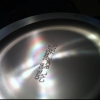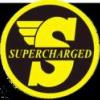
Blading An Knifedge Question
#16

Posted 08 January 2013 - 08:35 PM
#17

Posted 08 January 2013 - 08:38 PM
#18

Posted 08 January 2013 - 09:21 PM
#19

Posted 08 January 2013 - 09:27 PM
Having your crank 'bladed' or 'knife-edged' is unlikely to make it stronger. In fact making a sharp edge is more likey to make it weaker. What does make it stronger is stress relieving, which is basically using a sanding wheel/file whatever abrasive to clean the surface of the steel up until its smooth and any sharp edges rounded-off so there's no stress risers to start a crack. Once you do this you will then have to have it balanced again as material will have been removed.Okay but I don't want to keep my crank standard i want to improve it some how as my mate has kept his standard and it failed recently badly and i don't want that to happen to me
Incidently blading/knife edging removes metal from the counterbalancer web of the crank, of which i believe there is insufficient to start with. 'Wedging' on the other hand removes material from the big-end journal end thereby improving counterbalancing (and therefore smoothness of running) whilst also lightening the crank.
So basically its free to make your crank stronger, as long as your getting it balanced anyway!
Edited by TimmyG, 08 January 2013 - 09:28 PM.
#20

Posted 19 January 2013 - 08:18 PM
#21

Posted 19 January 2013 - 09:00 PM
Just make sure the crank is properly machined with good fillet radii in the journal corners. Having the corner radii too small is the main cause of crank failure.
You might want to re-think the SC drop gears if it's a road car. They are so noisy that you will need ear plugs on road journeys and are designed for competition use where a crash helmet is worn. They will cause hearing damage. I wish I had never fitted them to my rally 'S' and next bre-build they are coming out!
#22

Posted 19 January 2013 - 09:05 PM
And I don't know 100% on cam yet
And a center main strap will be fitted
#23

Posted 19 January 2013 - 09:26 PM
So for a high-revving crank it's the journal corner radii and the balancing which are most important.
Edited to add that I do have an EN40B 1275 'S' crank for sale completely original and never re-ground. It's cross-drilled and nitrided as standard and it's ready to fit after balancing with flywheel and front pulley. It can come complete with the required 'S' rods as well. If interested PM me.
Edited by Cooperman, 19 January 2013 - 09:28 PM.
#24

Posted 19 January 2013 - 10:29 PM
#25

Posted 20 January 2013 - 10:37 PM
I'm not convinced on straps, without line boring and a lot seems to depend on who machines the cap and bar. They must be perfect. By the time you have done all this a 4 bolt cap must be the best option?You really don't need to do anything other than a full dynamic balance and a centre main strap to get the 6700 rpm you'll need to fully use a 286 cam.
Just make sure the crank is properly machined with good fillet radii in the journal corners. Having the corner radii too small is the main cause of crank failure.
You might want to re-think the SC drop gears if it's a road car. They are so noisy that you will need ear plugs on road journeys and are designed for competition use where a crash helmet is worn. They will cause hearing damage. I wish I had never fitted them to my rally 'S' and next bre-build they are coming out!
#26

Posted 21 January 2013 - 01:59 PM
I'm not convinced on straps, without line boring and a lot seems to depend on who machines the cap and bar. They must be perfect. By the time you have done all this a 4 bolt cap must be the best option?
You really don't need to do anything other than a full dynamic balance and a centre main strap to get the 6700 rpm you'll need to fully use a 286 cam.
Just make sure the crank is properly machined with good fillet radii in the journal corners. Having the corner radii too small is the main cause of crank failure.
You might want to re-think the SC drop gears if it's a road car. They are so noisy that you will need ear plugs on road journeys and are designed for competition use where a crash helmet is worn. They will cause hearing damage. I wish I had never fitted them to my rally 'S' and next bre-build they are coming out!
Yes, for really high revs a 4-bolt high quality steel cap is absolutely ideal. For up to around 7000 rpm just a centre-main strap will help to avoid cap distoration so long as the cap is ground flat and the replacement bolts are very high tensile steel. Cap distortion and eventual metal fatigue is an issue with standard main caps and anything which helps reduce this is an advantage and will help the centre main bearing to last a bit longer as well. The problem with oil pressure at the centre main is that it has to go to lubricate two big ends, rather than just the single one as front & rear mains do, and there has to sufficient flow there to feed the thrust bearings. Plus the centre main will always tend to distort more than the end ones.
#27

Posted 21 January 2013 - 09:25 PM
I'm not convinced on straps, without line boring and a lot seems to depend on who machines the cap and bar. They must be perfect. By the time you have done all this a 4 bolt cap must be the best option?
You really don't need to do anything other than a full dynamic balance and a centre main strap to get the 6700 rpm you'll need to fully use a 286 cam.
Just make sure the crank is properly machined with good fillet radii in the journal corners. Having the corner radii too small is the main cause of crank failure.
You might want to re-think the SC drop gears if it's a road car. They are so noisy that you will need ear plugs on road journeys and are designed for competition use where a crash helmet is worn. They will cause hearing damage. I wish I had never fitted them to my rally 'S' and next bre-build they are coming out!
Yes, for really high revs a 4-bolt high quality steel cap is absolutely ideal. For up to around 7000 rpm just a centre-main strap will help to avoid cap distoration so long as the cap is ground flat and the replacement bolts are very high tensile steel. Cap distortion and eventual metal fatigue is an issue with standard main caps and anything which helps reduce this is an advantage and will help the centre main bearing to last a bit longer as well. The problem with oil pressure at the centre main is that it has to go to lubricate two big ends, rather than just the single one as front & rear mains do, and there has to sufficient flow there to feed the thrust bearings. Plus the centre main will always tend to distort more than the end ones.
I understand the theory I just wonder if the strap method can also cause the cap to change shape and nip up the bearing a little. I have seen some reports where It was critical the orientation of the strap when building the enigne.
I'm starting to believe that some of these mods need to be completed perfectly or they cause more issues than they solve?
I don't know I'm only starting to build my first engine, just what I have found from reading? I'm still undecided if I should strap or not....
Edited by Gr4h4m, 21 January 2013 - 10:20 PM.
#28

Posted 21 January 2013 - 09:32 PM
On race engines a 4-bolt line-honed steel cap is much better, but a bit 'overkill' for a road engine revving at not too much over 7000 rpm with a fully balanced bottom end.
#29

Posted 21 January 2013 - 10:09 PM
Edited by Gr4h4m, 21 January 2013 - 10:19 PM.
#30

Posted 21 January 2013 - 10:15 PM
1 user(s) are reading this topic
0 members, 1 guests, 0 anonymous users
















